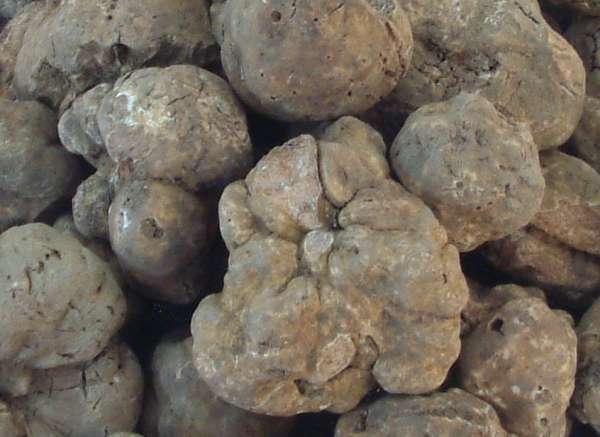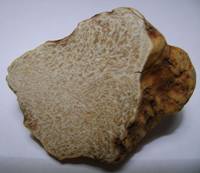Tuber magnatum Pico. - Piedmont White Truffle
Phylum: Ascomycota - Class: Pezizomycetes - Order: Pezizales - Family: Tuberaceae
Distribution - Taxonomic History - Etymology - Identification - Culinary Notes - Reference Sources

Tuber magnatum, the Piedmont White Truffle, grows in mycorrhizal relationship with the root systems of deciduous trees, mainly various Oaks and Hazel. In the city of Alba the annual White Truffle Fair and Market is held on weekends throughout October and until mid November, terminating in a World Truffle Auction.
A massive Piedmont Truffle weighing 1.5kg was auctioned in 2007 and fetched a third of a million US dollars. Picture: Moi-meme (public domain)
Truffles are ascomycetes, which shoot their spores from flasks (asci, singular ascus)... but how can they do that when they form underground? The answer is that truffles rely on animals digging them up and eating them. After the spores have passed through an animal's gut and have been excreted, they are able to produce a new mycelium that has the potential to link up with the root system of a new tree and so allow growth and propagation of the fungal species.
Piedmont White Truffles are the most aromatic of all truffle species. Cut one in halves and it gives off a most distinctive (but un-mushroomy) smell. Pigs, dogs and other creatures with noses more sensitive than ours can smell them from above ground. This is why truffle hunters use either pigs or dogs to help them locate these delicacies.
Distribution
The White Truffle or Piedmont Truffle is known to occur in the Piedmont area of northern Italy and in the Motovan Forest on the the Istria Peninsula in Croatia. So far this species has not been recorded from either Britain or Ireland. Being subterranean, these mushrooms are rarely seen by people walking in woodlands, and so their frequency of occurrence and exact location of sites are a matter of conjecture (and of commercial secrecy if you are a truffle merchant!). The market is never flooded with White Truffles, and so the price remains very high indeed.
Taxonomic history
When in 1788 Italian mycologist Pico described the Piedmont White Truffle he gave it the scientific binomial name Tuber magnatum, and that is still its generally-accepted scientific name.
Synonyms of Tuber magnatum include Tuber griseum Pers., and Tuber griseum (Pers.) Fr.
Etymology
Tuber, the generic name, comes directly from the Latin word tuber, meaning a lump or swelling. The specific epithet magnatum means 'of dignitaries' (from the same root as 'magnates', therefore, and meaning bigwigs!).
Identification guide
 |
FruitbodyThere is no point in trying to describe the shape of a truffle: they are the ultimate in shapelessness. Blobs, occasionally more or less spherical but most often irregularly multi-lobed, the outer surface of a Piedmont Truffle (once any earth has been washed off) is creamy brown and rather like that of a potato. There truffles are typically a few cm across and weigh 50 to 400g each, but exceptional specimens weighing over 1kg each are sometimes found. Inside, the cream or ochre spore-bearing material is marbled by white membranes in a random wandering form rather than any regular pattern. |
SporesEllipsoidal to subglobose, 35-50 x 32-42µm; ornamented with an irregular coarse reticulum. Spore massCreamy white or yellowish in mass. |
|
Habitat & Ecological role |
Mycorrhizal with various oaks and poplars as well as Hazel and Beech. |
Season |
Autumn. |
Similar species |
The Périgord Truffle Tuber melanosporum has a blackish surface covered in small crazed polygonal sections with shallow rivers between them; its spore-laden interior is darker than that of the Piedmont White Truffle. The Summer Truffle Tuber aestivum has a dark brown or black outer skin covered in irregular pyramidal warts. Inside, the spore-bearing material is initially white, becoming beige or grey-brown and marbled by white membranes in a random rather than regular pattern. |
Culinary Notes
White Truffles are highly-prized edible fungi. Truffles are so expensive to buy that they are generally shaved very thinly and added sparingly to a meal. One way to make a truffle go further is to extract 'truffle oil' from the fruitbody and use it as a spray. Most so-called truffle oil available in shops does not contain truffles at all but is produced synthetically to replicate (to some degree!) the unique odour of real truffles.
Reference Sources
Fascinated by Fungi, 2nd Edition, Pat O'Reilly 2016, reprinted by Coch-y-bonddu Books in 2022.
Dennis, R.W.G. (1981). British Ascomycetes; Lubrecht & Cramer; ISBN: 3768205525.
Breitenbach, J. & Kränzlin, F. (1984). Fungi of Switzerland. Volume 1: Ascomycetes. Verlag Mykologia: Luzern, Switzerland.
Medardi, G. (2006). Ascomiceti d'Italia. Centro Studi Micologici: Trento.
Dictionary of the Fungi; Paul M. Kirk, Paul F. Cannon, David W. Minter and J. A. Stalpers; CABI, 2008
Taxonomic history and synonym information on these pages is drawn from many sources but in particular from the British Mycological Society's GB Checklist of Fungi.
Fascinated by Fungi. Back by popular demand, Pat O'Reilly's best-selling 450-page hardback book is available now. The latest second edition was republished with a sparkling new cover design in September 2022 by Coch-y-Bonddu Books. Full details and copies are available from the publisher's online bookshop...

